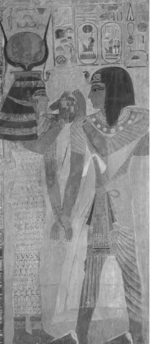Temple of Seti I Helicopter hieroglyphs: Difference between revisions
mNo edit summary |
|||
| Line 22: | Line 22: | ||
After excavating, archeologists found multiple rooms and gardens at the temple. The water garden was excavated and it revealed many images of rituals practiced by Seti and the Gods. The art found across the walls of the temple showed what Seti hoped to keep after his passing, the importance of the afterlife. | After excavating, archeologists found multiple rooms and gardens at the temple. The water garden was excavated and it revealed many images of rituals practiced by Seti and the Gods. The art found across the walls of the temple showed what Seti hoped to keep after his passing, the importance of the afterlife. | ||
During the excavation, there were strange hieroglyphs that revealed head turning images that would make pseudoarchaeologist question if Egyptians were aware of modern technology like tanks, blimps, and helicopters. | |||
Revision as of 19:30, 28 November 2017

The Temple of Seti I was constructed in memory of the 19th Dynasty and it was completed by his son, Ramesses II. Part of the plaster in the overhang has crumbled, revealing some interesting and unique hieroglyphics. They depicted strangely similar modern machines that caused eyebrows to raise wondering if Egyptians knew about modern technology.
Pharaoh Seti I

Seti I was the son of Ramses I and Queen Sitre. He followed the footsteps of his father, which was to become a military man. While in the military, he earned multiple titles, like troop commander, vizier and head archer, and this made him to be considered a powerful man throughout Egypt. He reigned from 1291 to 1279 BCE. Since his father only reigned Egypt for 2 years, people claimed that Seti was the real founder of the greatness of the Ramessids. During his reign, he led his army northward to restore Egyptian prestige. He battled in northern Palestine and Syria, but ended it with a peace treaty that may have established the frontier at Kadesh on the Orontes River. Seti truly made Egypt prosper during his reign. He fortified the frontier, dug wells, open mines, rebuilt temples and shrines that have been falling apart, and continued the work of his father in completing the great hypostyle hall at Karnak, which is deemed to be the most magnificent monument in Egyptian architecture.
Temple of Seti I
The Temple of Seti I is located in Abydos, which is where many important and well-known pharaohs were buried. This temple is considered among the finest examples of ancient Egyptian art, also one of the largest memorial temples located along the edge of the floodplain to the south of Osiris’ Abydos temple. Seti I wanted his whole temple to be adorn with this type of Egyptian art, which was the largest in the Valley of the Kings at Thebes. This temple was not completed while Seti I was still alive. His son, Ramses II, who succeeded his father and became one of the greatest pharaohs of Ancient Egypt, completed Seti I's temple during his reign.
Temple of Seti I's Art
Seti I had an interesting technique with the art around his temple. Mysliwiec noticed that there were two different types of styles Seti I used before and after his death. He believed that it corresponded to the earlier part of his reign when the chapel for his father, Ramesses I, was being decorated at Arybos and later in his life when he passed away and his son, Ramesses II, took over the construction and decoration. Once Ramesses II took over, he decided to change some of the writing his father put in the temple.
Finding The Temple of Seti I
This temple was not really excavated as it was standing when it was found. The main focus of this temple was to draw it out to figure out where everything was placed and to take photos. Egypt Exploration Society in 1927 hired Amice Mary Caverley to work on copying the huge scenes in huge temples by hand under the direction of Egyptologist Alan H. Gardner. She headed to Egypt in the winter of 1928/29 to photograph and draw everything in the Temple of Seti I, by herself. The temple was enormous and rich with intricate art that all needed to be recorded. It would have taken Carverley some time to develop some new methods to conquer what was in the temple and around the camp.

Over time, the temple started becoming popular amongst archaeologists that they began to excavate it. A geographic scan was done that enabled archaeologists to view the hidden rooms around the temple. The temple is so immense that it continues to be excavated today. The benefit about excavating it, is the fact that most of it is unearthed and standing. Tourist can visit the temple today and have a glance of the beauty.
Archaeologists and Egyptologists had quite the eccentric journey after meeting Dorothy Eady, also known as Omm Sety. She said she would have visions of being with the Pharaoh himself, Seti I. Strangely, people actually believed her when she would claim certain things. Most Egyptologists took her word for many things because she mentioned things that were not found yet. This kept them astounded and believed that she was actually speaking to Seti I. She retired in 1969, but continued to guide tours. Dorothy Eady passed away when she was 81 and was laid to rest next to her lover, Seti I.
After excavating, archeologists found multiple rooms and gardens at the temple. The water garden was excavated and it revealed many images of rituals practiced by Seti and the Gods. The art found across the walls of the temple showed what Seti hoped to keep after his passing, the importance of the afterlife.
During the excavation, there were strange hieroglyphs that revealed head turning images that would make pseudoarchaeologist question if Egyptians were aware of modern technology like tanks, blimps, and helicopters.